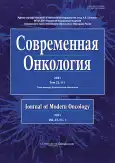V-образный кожно-фасциальный лучевой лоскут – новый способ снижения морбидности донорской зоны
- Авторы: Болотин М.В.1, Мудунов А.М.2, Соболевский В.И.1, Ахундов А.А.1, Гельфанд И.М.1, Сопромадзе С.В.1
-
Учреждения:
- ФГБУ «Национальный медицинский исследовательский центр онкологии им. Н.Н. Блохина» Минздрава России
- Клинический госпиталь «Лапино»
- Выпуск: Том 23, № 3 (2021)
- Страницы: 513-517
- Раздел: КЛИНИЧЕСКАЯ ОНКОЛОГИЯ
- URL: https://journals.rcsi.science/1815-1434/article/view/63442
- DOI: https://doi.org/10.26442/18151434.2021.3.200987
- ID: 63442
Цитировать
Полный текст
Аннотация
Обоснование. Лучевой кожно-фасциальный лоскут – один из наиболее часто используемых способов для реконструкции дефектов, образующихся после удаления злокачественных опухолей головы и шеи. Значительным недостатком является внешний вид донорского места после забора лоскута. Мы разработали и внедрили в клиническую практику V-образную фабрикацию кожной площадки лоскута, что позволяет осуществить «прямое» закрытие донорского ложа и снизить его морбидность.
Цель. Оценить возможность «прямого» закрытия донорского ложа и снизить морбидность донорского места при выполнении методики V-образной фабрикации кожной площадки лоскута.
Материалы и методы. За период с 2014 по 2020 г. в отделении опухолей головы и шеи ФГБУ «НМИЦ онкологии им. Н.Н. Блохина» лучевой кожно-фасциальный лоскут использовался для реконструкции дефектов, образующихся после удаления злокачественных опухолей головы в 43 случаях. В 15 (35%) наблюдениях при заборе лоскута применили V-образную фабрикацию кожной площадки, что позволило осуществить «прямое» закрытие донорского ложа. Длина кожной площадки простиралась от запястья сверху, не доходя 3–4 см до локтевого сгиба снизу, и варьировала от 7 до 15 см, в среднем 12 см. Ширина лоскута определялась эластичностью кожи предплечья, была максимальной в средней трети и варьировала от 2 до 4 см, в среднем составив 3,3 см. В случае необходимости верхний и нижний края кожной площадки могут быть сшиты между собой, так же, как и весь медиальный край лоскута. Этот прием увеличивает ширину лоскута почти в 2 раза. Такая компоновка была применена в 8 случаях.
Результаты. При сравнении результатов использования 2 методик получены следующие данные: V-образная фабрикация кожной площадки применялась в основном у женщин (11/15 – 73%) для закрытия ограниченных дефектов ретромолярной области (5/15), мягкого (4/15) или твердого неба (6/15). Большинство больных были с локализованными процессами категории T1-T2 (10/15). Ни у одного пациента не отмечалось проблем с заживлением донорской зоны. Во всех наблюдениях получен отличный эстетический результат. В группе стандартного забора отмечено преобладание лиц мужского пола (17/28). Дефекты имели разнообразную локализацию, большинство пациентов были с рецидивами после химиолучевого лечения (10/28) или первичным местно-распространенным процессом категории T3-T4 (6/28) – 16, с локализованным процессом категории T1-T2 (11/28) – 11, в 1 случае была выполнена отсроченная реконструкция по поводу рубцовой деформации после предшествующего комбинированного лечения. Во всех случаях пластика донорского ложа осуществлена расщепленным кожным аутотрансплантатом. Частичный некроз лоскута донорской зоны отмечен у 9 (32%) пациентов, в 4 случаях – с обнажением сухожилия мышц сгибателей.
Заключение. В результате проведенного сравнительного анализа 2 методик мы пришли к выводу, что использование V-образной фабрикации кожной площадки лучевого лоскута позволяет получить лучшие эстетические результаты со стороны донорского ложа, однако применение данной методики приводит к значительному уменьшение длины сосудистой ножки, уменьшению ширины кожной площадки.
Ключевые слова
Полный текст
Открыть статью на сайте журналаОб авторах
Михаил Викторович Болотин
ФГБУ «Национальный медицинский исследовательский центр онкологии им. Н.Н. Блохина» Минздрава России
Автор, ответственный за переписку.
Email: bolotin1980@mail.ru
ORCID iD: 0000-0001-7534-6565
SPIN-код: 6105-5486
канд. мед. наук, ст. науч. сотр.
Россия, МоскваАли Мурадович Мудунов
Клинический госпиталь «Лапино»
Email: bolotin1980@mail.ru
ORCID iD: 0000-0003-1255-5700
SPIN-код: 3516-6616
д-р мед. наук, проф., зав. отд-нием
Россия, Московская областьВасилий Иванович Соболевский
ФГБУ «Национальный медицинский исследовательский центр онкологии им. Н.Н. Блохина» Минздрава России
Email: bolotin1980@mail.ru
ORCID iD: 0000-0003-3668-0741
д-р мед. наук, проф., зав. отд-нием
Россия, МоскваАзер Алиевич Ахундов
ФГБУ «Национальный медицинский исследовательский центр онкологии им. Н.Н. Блохина» Минздрава России
Email: bolotin1980@mail.ru
ORCID iD: 0000-0002-9543-990X
SPIN-код: 8895-9447
д-р мед. наук, ст. науч. сотр
Россия, МоскваИгорь Михайлович Гельфанд
ФГБУ «Национальный медицинский исследовательский центр онкологии им. Н.Н. Блохина» Минздрава России
Email: bolotin1980@mail.ru
ORCID iD: 0000-0002-4496-6128
SPIN-код: 7641-2039
канд. мед. наук, врач-онколог
Россия, МоскваСофио Васоевна Сопромадзе
ФГБУ «Национальный медицинский исследовательский центр онкологии им. Н.Н. Блохина» Минздрава России
Email: bolotin1980@mail.ru
врач-онколог
Россия, МоскваСписок литературы
- Muhlbauer W, HerndI E, Stock W. The forearm flap. Plast Reconstr Surg. 1982;70(3):336-44.
- Boorman JG, Green MF. A split Chinese forearm flap for simultaneous oral lining and skin cover. Br J Plast Surg. 1986;39(2):179-82.
- Yang G, Chen B, Gao Y, et al. Forearm free skin flap transplantation. Natl Med J China. 1981;61:139-41.
- Song R, Gao Y, Song Y, et al. The forearm flap. Clin Plast Surg. 1982;9:21-6.
- Muhlbauer W, Olbrisch R.R, HerndI E, Stock W. Die Behandlung der Halskontraktur nach Verbrennung mit dem freien Unterarmlappen. Chirurg. 1981;52:635.
- Bardsley AF, Soutar DS, Elliot D, Batchelor AG. Reducing morbidity in the radial forearm flap donor site. Plast Reconstr Surg. 1990;86(2):287-92;dis. 293-4.
- Hallock GG. Cutaneous cover for cutaneous coverage. Contemp Orthop. 1990;21:234.
- Masser MR. The preexpanded radial free flap. Plast Reconstr Surg. 1990;86(2):295-301.
- Elliot D, Bardsley AF, Batchelor AG, Soutar DS. Direct closure of the radial forearm flap donor defect. Br J Plast Surg. 1988;41(4):358-60.
- Fenton OM, Roberts JO. Improving the donor site of the radial forearm flap. Br J Plast Surg. 1985;38(4):504-5.
- Timmons MJ, Missotten FE, Poole MD, Davies DM. Complications of radial forearm flap donor sites. Br J Plast Surg. 1986;39(2):176-8.
Дополнительные файлы















